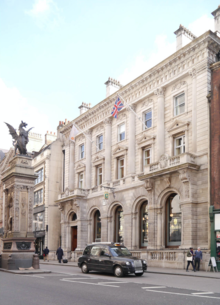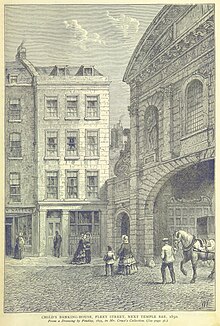Child & Co.
 | |
 | |
| Type | Subsidiary |
|---|---|
| Industry | Private banking and wealth management |
| Founded | 1664 |
| Headquarters | 1 Fleet Street, London, EC4 United Kingdom |
| Products | Wealth management, lending and savings |
| Parent | Royal Bank of Scotland |
| Website | Child & Co. |
Child & Co. is a private bank. Founded in 1664 it is the oldest bank in the United Kingdom, and the third oldest bank in the world. Formerly independent it is now owned by the NatWest Group. The Royal Bank of Scotland incorporating Child & Co., Bankers is based at 1 Fleet Street on the western edge of the City of London, beside Temple Bar Memorial and opposite the Royal Courts of Justice. Child & Co. is authorised as a brand of The Royal Bank of Scotland by the Prudential Regulation Authority.[1]
History[]

Child & Co. is the third oldest bank in the world and is the oldest bank in the UK, predating the Bank of England.
Early beginnings[]
Child & Co. is the oldest independent financial institution in the UK, and can trace its roots back to a London goldsmith business in the late 17th century. Sir Francis Child established his business as a goldsmith in 1664, when he entered into partnership with Robert Blanchard. Child married Blanchard's stepdaughter and inherited the whole business on Blanchard's death. Renamed Child and Co, the business thrived, and was appointed the "jeweller in ordinary" to King William III.
Sir Francis Child took over most of the assets of Coggs & Dann a goldsmith banker "at the sign of the Kings Head in the Strand, over against St. Clement Danes Church",[2] after the bank became insolvent in 1710 due to a massive fraud, orchestrated by gentleman fraudster Thomas Brerewood, which became known as the Pitkin Affair.[3]
After Child died in 1713, his three sons ran the business, and during this time, the business transformed from a goldsmith's to a fully fledged bank. The bank claims it was the first to introduce a pre-printed cheque form, prior to which customers simply wrote a letter to their bank but sent it to their creditor who presented it for payment. Its first bank note was issued in 1729.
Sarah Fane, Countess of Westmorland[]
By 1782, Child's grandson Robert Child was the senior partner in the firm. However, when he died in 1782 without any sons to inherit the business, he did not want to leave it to his only daughter, Sarah Anne Child, because he was furious over her elopement with John Fane, 10th Earl of Westmorland earlier in the year. To prevent the Earls of Westmorland from ever acquiring his wealth, he left it in trust to his daughter's second surviving son or eldest daughter. This turned out to be Lady Sarah Sophia Fane, who was born in 1785. Between the death of Robert Child in 1782 and until 1793, the bank was managed by his widow, Sarah Child. Her and Robert's granddaughter Sarah Sophia Fane married George Child-Villiers, 5th Earl of Jersey in 1804, and upon her majority in 1806 she became senior partner. She exercised her rights personally until her death in 1867. At that point the Earl of Jersey & Frederick William Price of Harringay House were appointed as the two leading partners.[4] Ownership continued in the Jersey family until the 1920s.
Later periods, and Glyn, Mills & Co.[]
George, 8th Earl of Jersey sold the bank to Glyn, Mills, Currie, Holt & Co. in 1924, who retained Child & Co. as a separate business. Glyn, Mills & Co. was in turn acquired by The Royal Bank of Scotland in 1931 and merged with Williams Deacon's Bank in 1969 to form Williams & Glyn's Bank. Williams and Glyn's Bank was fully integrated into The Royal Bank of Scotland in 1985 and ceased to operate separately.
During World War II the main banking departments were evacuated to Osterley in West London, and in 1942 the Oxford branch was transferred to Martins Bank.
Location[]
Child & Co. occupies a grand Grade II* listed building, designed by eminent architect John Gibson, at 1 Fleet Street on the western edge of the City of London. The bank has traded from the same Fleet Street site since 1673. Its current home was opened on the site in 1880 and refurbished in 2015.[5]
Clientele[]
Over their 350-year history Child & Co has attracted an exclusive client base including The Honourable Societies of Middle Temple and Lincoln's Inn, and numerous landowning families. Scholars of the Inns receive their awards by cheques drawn on Child & Co, and many barristers continue to use the bank throughout their professional lives. Several universities including The London School of Economics, Oxford University, and Imperial College London are reported to hold accounts. Until 1979 there was a 'representative office' (technically not a branch) at St. Giles’, Oxford. This was conveniently near the richest college in Oxford, St John's College, who still bank with them today.
Child & Co. has a legal and professional services hub that supports many of the biggest law firms in the UK, as well as three of the Big Four accounting firms in the UK.
It is believed that the bank became the model for Charles Dickens' fictitious Tellson's Bank, in A Tale of Two Cities (1859).
Relationship with Royal Bank of Scotland[]
Child & Co. is authorised by the Prudential Regulation Authority and regulated by both the Financial Conduct Authority and the Prudential Regulation Authority.
Child & Co. for the purposes of the Financial Services Compensation Scheme operates as a brand of the Royal Bank of Scotland.[6]
See also[]
References[]
- Notes
- ^ Financial Services Authority (1 June 2010). "UK banking and savings groups". Retrieved 20 September 2010.
- ^ The London Goldsmiths 1200-1800, Sir Ambrose Heal, page 127
- ^ Mr Bridgman's Accomplice, Long Ben's Coxswain 1660-1722, John Dann, 2019, page 25 ISBN 9781784566364
- ^ "No. 4300". The London Gazette. 26 February 1876. p. 698.
- ^ "Child & Co. – Understanding our brands".
- ^ "Legal information". Royal Bank of Scotland. 2013. Retrieved 25 June 2013.
- Bibliography
- "Child & Co, London, c.1580s-date". RBS Heritage Online. Royal Bank of Scotland Group. Retrieved 22 February 2014.
- Donald Adamson, "Child’s Bank and Oxford University in the Eighteenth Century", The Three Banks Review, December 1982, pp. 45–52
- Philip Clarke The FIrst House in the City (1973)
External links[]
- Private banks
- Royal Bank of Scotland
- Organisations based in the City of London
- Banks established in 1664
- 1664 establishments in England
- Banking in Great Britain
